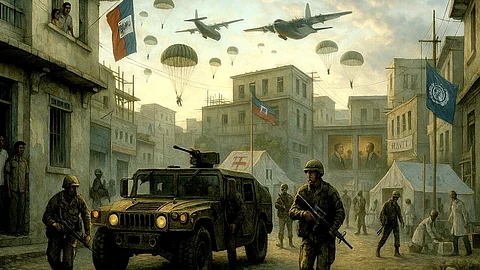
- Home
- न्यूजग्राम
- India
- World
- Politics
- Entertainment
- Culture
- Lifestyle
- Economy
- Sports
- Sp. Coverage
- Misc.
- NewsGram Exclusive
- Jobs / Internships

In September 1994, the U.S. led a military mission to remove Haiti’s military junta without combat.
A high-level U.S. delegation negotiated General Cédras’s resignation just hours before a planned invasion, turning a military operation into a peaceful intervention.
While Aristide returned, Haitians were disillusioned by U.S. leniency toward coup leaders
One day in September 1994, Haiti woke up to the roar of aircraft overhead and the shadow of foreign soldiers descending upon its land. Within just four hours, U.S. troops had landed, military vehicles rolled through Port-au-Prince, and airports were quietly seized. The entire country watched, stunned, as a tense but bloodless military operation unfolded without a single battle.
But what looked like an invasion was something far more complex.
This was Operation Uphold Democracy—a U.S.-led multinational military mission designed not to conquer, but to replace a dictatorship with a democracy. Ironically, the same democratic government it was now restoring had once been undermined with the tacit support of the same international actors.
Haiti’s fragile democratic journey had begun in 1990 with the election of Father Jean-Bertrand Aristide—the country’s first freely chosen president. Just a year later, on September 30, 1991, that journey was violently interrupted. A military coup led by Lieutenant General Raoul Cédras ousted Aristide and plunged the country into authoritarian rule. Backed by the Armed Forces of Haiti (FAd’H), Cédras installed a junta that would cling to power for three bloody years.
The United States and the Organization of American States responded with economic sanctions, diplomatic isolation, and humanitarian pressure, but the junta refused to budge. During this period, thousands of Haitians fled by boat, with many intercepted and forcibly sent back, first under President George H.W. Bush and then by his successor, Bill Clinton.
Despite efforts like the 1993 Governors Island Accord, a U.N. and OAS-brokered deal for Aristide's peaceful return—the Haitian military repeatedly broke promises. The USS Harlan County, sent to prepare for Aristide’s return, was forced to retreat when Cédras’ loyalists threatened violence at the docks.
The diplomatic embarrassment underscored the junta’s defiance, and by mid-1994, the Clinton administration began preparing for a possible military intervention. Behind the scenes, plans under the codename Operation Uphold Democracy came together: two aircraft carriers, 25,000 troops, and Special Forces were staged across the Caribbean, ready for forced entry.
On July 31, 1994, the United Nations Security Council passed Resolution 940, authorizing the use of “all necessary means” to restore Haiti’s democracy. It was the first time the UN sanctioned military force to reinstate an elected government.
As invasion day neared—September 19—former U.S. President Jimmy Carter, Senator Sam Nunn, and General Colin Powell flew to Haiti on September 17, in a last-ditch effort to negotiate Cédras’s resignation. Clinton gave them just hours: the invasion was already in motion.
With aircraft in the air, paratroopers poised, and warships closing in, the delegation reportedly showed Cédras a video of U.S. troops already deploying. They made it clear: resist, and face a full-blown American military assault. Cédras folded.
Shelton and Cédras met on September 20, 1994, to begin the process. U.S. forces, who had prepared for a combat landing, shifted to peacekeeping mode overnight. Soldiers on the ground were ordered to cooperate with local security, avoid confrontation, and stabilize the capital without triggering chaos. But tensions remained.
Though Aristide would return on October 15, his homecoming was muted by bitterness. In the book “Invasion, Intervention, ‘Intervasion’: A Concise History of the U.S. Army in Operation Uphold Democracy” written by Kretchik et al., it is mentioned that many Haitians, who had expected the Americans to punish the coup leaders, were shocked to see U.S. soldiers working alongside members of the hated FAd’H. In Port-au-Prince, U.S. Marines witnessed police brutality against unarmed protesters and initially did not intervene. Public outrage, both Haitian and American, forced a change in engagement rules.
Elsewhere, U.S. troops had freer rein. In Cap-Haïtien, Marines quickly engaged and neutralized a threatening FAd’H unit, earning praise from civilians. These scattered skirmishes helped cement U.S. authority, but resentment simmered over the U.S.’s soft approach toward the junta’s remnants.
From Invasion to Nation-Building
Despite initial tensions, the mission gradually evolved into a broader peacekeeping and rebuilding effort. Humanitarian teams, logistical experts, and medical units arrived. Psychological operations were launched to reassure the public. The 10th Mountain Division gave way to the 25th Infantry Division, which oversaw the transition to the United Nations Mission in Haiti (UNMIH).
The U.S. had avoided a bloody invasion—but at the cost of difficult compromises.
See Also:
The 1994 Haiti intervention remains one of the fastest and most logistically complex military deployments in modern history. It was also a moment of contradiction: a nation that had once supported Aristide’s ouster returned to restore him. A military invasion disguised as a rescue mission. A show of overwhelming force that ended not in conquest, but in careful diplomacy and political restoration.
In the end, Operation Uphold Democracy didn't just change Haiti—it revealed the contours of a new post-Cold War American foreign policy. One where nation-building, diplomacy, military projection, and humanitarian goals collided in real time.
And it all happened in the time it takes to watch a movie. [Rh/VP]
